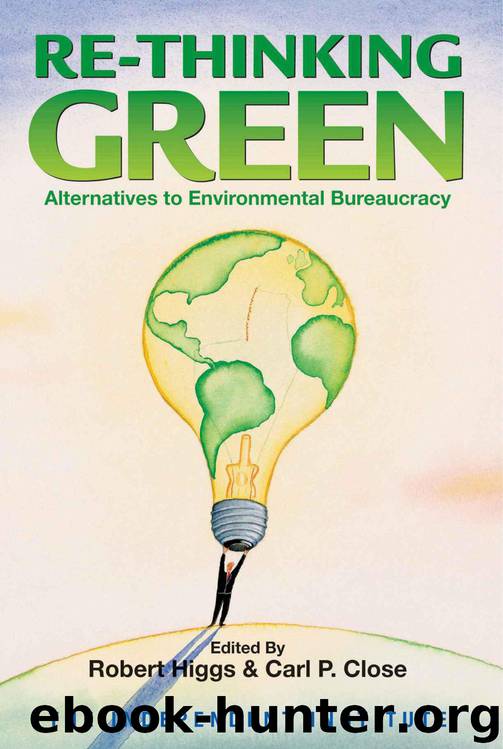Re-Thinking Green: Alternatives to Environmental Bureaucracy by Robert Higgs

Author:Robert Higgs [Higgs, Robert]
Language: eng
Format: epub
Publisher: Independent Publishers Group
Published: 2012-08-31T22:00:00+00:00
CONCLUSION
Private developers are making significant efforts to protect environmental resources that add to the net collective value of the community. These efforts are simply profit-maximizing behavior by developers responding to property owners’ growing demands to protect the environment and preserve the natural landscape. Large-scale developers are more likely than small-scale developers to protect common pool resources because the larger developers are better able to capture the benefits of their actions. This difference is especially evident in coastal areas.
But even in coastal areas, private development cannot solve all environmental problems. For some common property resources, such as fisheries, where access is not controlled and property rights are not well defined, environmental problems continue. Moreover, property rights do not extend beyond the island's environment.17 For example, upstream dams deprive coastal beaches of sand, and pollution runoff from farm and urban developments damages coastal estuaries. Furthermore, developers do not operate without making mistakes, and in some cases they actually ignore environmental concerns—for instance, it seems clear in hindsight that some buildings were constructed too close to the ocean on Seabrook Island. Utopias rarely, if ever, exist. We can only choose the course of action that promises the best feasible outcome. For coastal development, the market demonstrates significant compatibility between entrepreneurial activity and environmental concern.
Studies of cases such as Sea Pines, Seabrook, Kiawah, and Dewees are useful in determining how successful this approach may be in the long term. For a community of property owners with similar tastes and a strong system of protective covenants, our research suggests that the potential for long-term and widespread success is substantial.
Human beings have a desire for environmental goods such as scenic views, clear skies, clean water, space, and a feeling of harmony with nature. Community developers, such as those on barrier islands, package environmental amenities along with other attractions and receive compensation from property prices in exactly the same way that Wal-Mart profits by selling tennis rackets, golf clubs, electronic equipment, and clothing. This process is under way in many other areas of the country. As consumer affluence and environmental knowledge grow, this movement will accelerate.
Download
This site does not store any files on its server. We only index and link to content provided by other sites. Please contact the content providers to delete copyright contents if any and email us, we'll remove relevant links or contents immediately.
The Secret History by Donna Tartt(18840)
The Social Justice Warrior Handbook by Lisa De Pasquale(12141)
Thirteen Reasons Why by Jay Asher(8791)
This Is How You Lose Her by Junot Diaz(6778)
Weapons of Math Destruction by Cathy O'Neil(6139)
Zero to One by Peter Thiel(5684)
Beartown by Fredrik Backman(5594)
The Myth of the Strong Leader by Archie Brown(5421)
The Fire Next Time by James Baldwin(5246)
How Democracies Die by Steven Levitsky & Daniel Ziblatt(5127)
Promise Me, Dad by Joe Biden(5087)
Stone's Rules by Roger Stone(5026)
100 Deadly Skills by Clint Emerson(4840)
A Higher Loyalty: Truth, Lies, and Leadership by James Comey(4840)
Rise and Kill First by Ronen Bergman(4701)
Secrecy World by Jake Bernstein(4640)
The David Icke Guide to the Global Conspiracy (and how to end it) by David Icke(4624)
The Farm by Tom Rob Smith(4434)
The Doomsday Machine by Daniel Ellsberg(4415)
